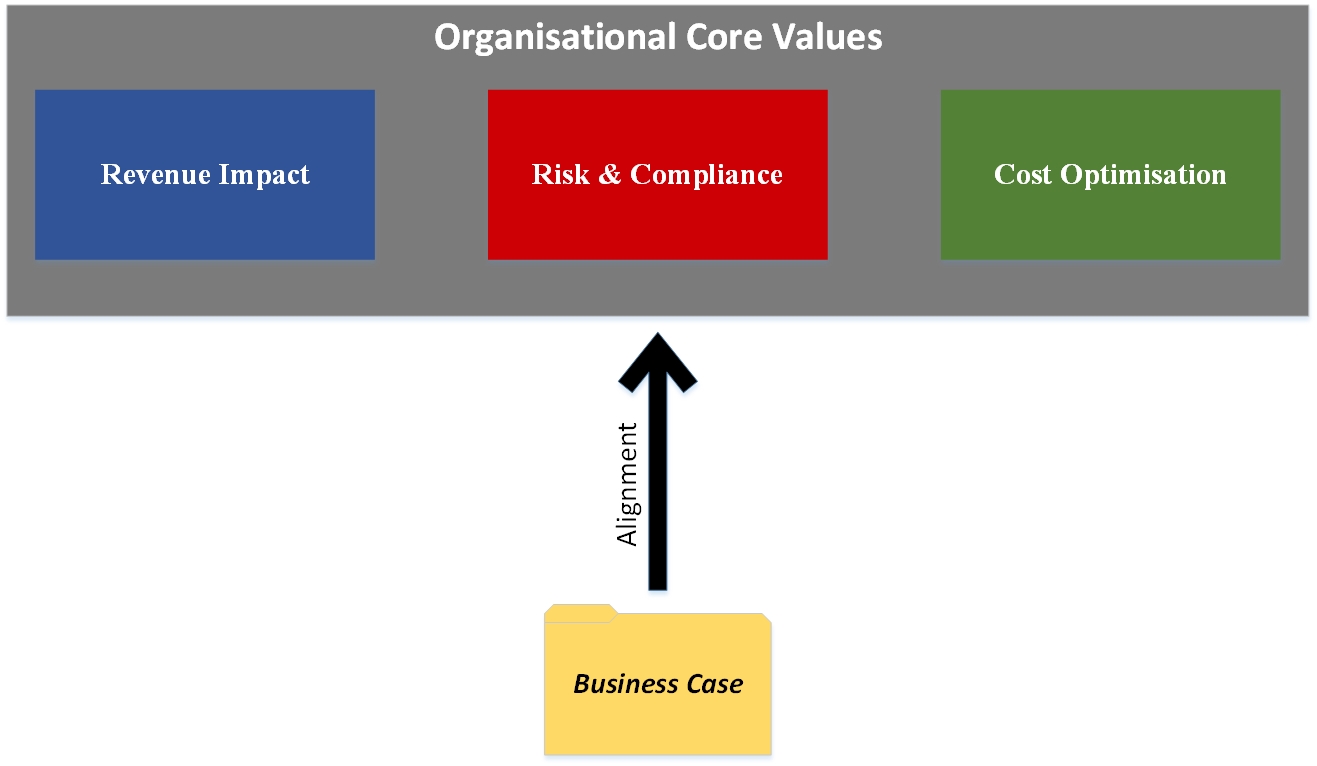 Aligning Business Case with Organisational Core Value
Aligning Business Case with Organisational Core Value
Today, IT projects are being heavily scrutinised and asked to provide a business/investment case to show value offered by the proposed project. The concept of writing a business case is alien to most professionals in information technology, who tend to be technical in nature. So how do you write a compelling business case that will get the budget approval? Where do you start?
In this post, I will provide an overview of approach to building a compelling business/Investment case. I would like to start with something called “Project Portfolio Governance“. This is a framework for organisations where projects are weighed against each other and selected based on how closely they are aligned with organisation’s strategic objectives and roadmap. Each business case is assigned a certain weight and goes to committee review, that ultimately decides which projects will get funding.
Most enterprise clients I have worked with, have three core values they use to evaluate projects against each other.
Revenue Impact: How will your project increase revenue?
Cost Optimisation: How will your project reduce costs for organisation?
Risk & Compliance: What risk will your project mitigate against? What regulations will your project help your organisation comply with?
It is important to understand your enterprise strategy objectives and KPIs used to measure its success. For example, your CEO might have a new strategy that commits to increasing revenue by 10% over the next 18 month. Other divisional strategies within the organisation will be closely aligned with the CEO’s strategy and so should yours.
Which of the above core values is your organisation is focused on? How do you get your project aligned with these values? I will focus on Revenue Impact as a real life example I was involved in.
Revenue Impact
IT is perceived in most organisation to have the sole job of keeping lights on. Adding to revenue is not an activity associated with IT. You will need to spend an extra effort aligning with this organisational core value. But first you will need to identify which of the following is used to benchmark your project:
- ROI (Return on Investment)
- NPV (Net Present Value)
- IRR (Internal Rate of Return)
- TCO (Total Cost of Ownership)
- OpEx vs CapEx
Then once identified relevant tools, we can utilise to support our business case.
Let me illustrate with an example of an actual engagement where I worked with a client to develop a business case.
Example
The project was the justification of the adoption of Artificial Intelligence (AI) and Machine Learning (ML) in a sales division. first submission of business case was not successful. The benefits listed were fairly generic: AI will give data insight, do automation, etc. The business case failed to articulate the real value of the proposed project and how it is aligned with organisation’s top strategies.
A new approach was needed.
The Challenge:
On average, sales people in the organisation were wasting 40% of their time on manual and repeatable administrative tasks , such as frequent CRM updates, filling out forms, reports, updating sales pipeline, and post sales administration activities.
The Solution:
With revenue growth as the top core value identified in the organisation, focus on revenue growth was going to be the focused of the revised business case.
AI/ML can automate most of the time consuming repeatable sales administrative tasks, which allows the sales force to focus on prospecting and generating new revenue. AI/ML can also analyse data of their past/existing clients to identify their purchasing and behavioural patterns. AI/ML will then, prioritise opportunities based on where they are in the sales cycle.
Benefit:
It was determined, based on automation and analytics capabilities, sales would increase conservatively by 10% which would equate to $12 million a year increase in revenue. Now we have articulated to the board how an increase of $12million a year in revenue is closely aligned with corporate strategy. With cost of implementing the AI/ML and the increase in revenue, the ROI was forecasted it would take 10 month to recoup costs of project. (There are other investment measuring metrics that can be used to measure projects against each other which I will cover more details in a future post).
Cost Optimisation:
Similarly, if cost optimisation is the top core value in your organisation, then you need to articulate how your project will reduce costs.
Risk & Compliance
This is another core value that many organisations list as a top priority. You will need to identify what is defined as risk in your organisation and what regulations you need to comply with, and align your project with it.
Conclusion
Now imagine your organisation has a serious data breach, and as a result, it sustained a damage to the brand name and significant financial penalties. You can be rest assured, in the short to medium term, the priority will be given to security enhancing projects. Although your business case might show significant savings as the key benefit, it will likely score low against security focused projects.
This approach, I have found to be very effective in getting approvals for business/investment cases.
I hope you have found this post informative. Thank you for reading & sharing.
Regards,
Nick






Mark
July 21, 2019Logical take on building a business case. How many pages would you recommend for business case?
Mark
Virtual Tarzan
July 21, 2019Hi Mark, I would aim for 1-2 pages business case. Be concise and straight to the point.
Mark
July 22, 20191 to 2 pageS??? I am working on one now that will be 10 to 12 pages long!!! I thought you need to add all details …
Virtual Tarzan
July 22, 2019Most business cases are submitted in support of a proposed project. Details are usually scarce at this stage. I suggest to keep business case light and straight to the point. From experience, steering committees tend to be suspicious of long detailed business cases, and often think that data has been “massaged” a bit. It is best to be transparent, list benefits (aligned to core values) and highlight that it is an estimate. This approach has worked for me in the past. Also, steering committees tend to not be keen on reading a War & Peace size business case! 🙂
Sam
July 24, 2019What information would you include in your use case?
Virtual Tarzan
July 25, 2019Hi Sam, you have to be careful not to confuse Use Case with Business Case. Use Case addresses how the solution will be used by users. Business Case on the other hand, focuses on benefits of the solution and the cost associated with it. Often, the Business Case will include different use cases of the solution and their benefit.
As for information I would include in Business Case:
– Objective: Overview of the project and the problem the proposed project will solve
– Scope: Define the boundaries of the project, what will it do and not do. What areas of the organisation, technologies, processes will be impacted
– Assumptions: Any assumption made (existing technologies, skills, time frame, etc.)
– Timeframe: How long will it take to deliver the project
– Risk: Any risks the project will introduce and proposed risk mitigation
– Cost: Total estimated cost of project
– Revenue: Total expected revenue (using supported financial measuring tools)
CloudGuru
July 27, 2019This is really helpful. Thank you